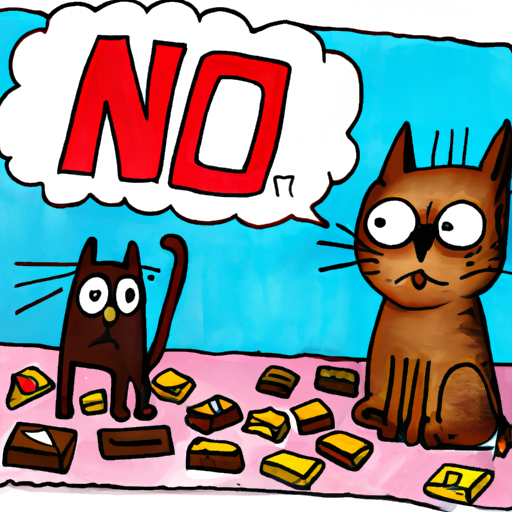Chocolate. A treat that’s loved by people around the world. Its rich, creamy taste and intoxicating aroma can make even the most disciplined among us give in to temptation. But, while it’s a much-loved indulgence for humans, it’s a different story for our furry friends. Chocolate is toxic to both cats and dogs, and it’s important for every pet owner to understand why.
Table of Contents
- The Dangers of Chocolate
- Why Chocolate is Toxic
- Symptoms of Chocolate Poisoning in Pets
- What to Do if Your Pet Eats Chocolate
- Frequently Asked Questions
Key Takeaways
- Chocolate is harmful to both dogs and cats due to a compound it contains called theobromine.
- The toxicity level of chocolate depends on the type and amount consumed, as well as the size and health of the pet.
- Early signs of chocolate poisoning include restlessness, increased thirst, and vomiting.
- If you suspect your pet has consumed chocolate, contact your vet immediately.
The Dangers of Chocolate
The problem with chocolate is a compound it contains called theobromine. This is a stimulant that affects the central nervous system and cardiovascular system. While our bodies can metabolize this compound without difficulty, it’s a different story for our pets. Animals process theobromine much more slowly, allowing it to build up to toxic levels in their system.
Why Chocolate is Toxic
Theobromine affects pets similarly to how caffeine affects humans. It stimulates the nervous system, causing symptoms like restlessness and increased heart rate. However, unlike humans, cats and dogs are much more sensitive to these effects. Even a small amount of chocolate can lead to theobromine poisoning in pets.
The severity of the poisoning depends on several factors, including the type and amount of chocolate consumed, as well as the size, age, and overall health of the pet. Dark chocolate, cocoa powder, and baking chocolate are the most toxic types, as they contain higher levels of theobromine.
Here’s a table that shows the approximate theobromine content in different types of chocolate:
| Type of Chocolate | Theobromine per Ounce |
|---|---|
| Milk Chocolate | 60 mg |
| Dark Chocolate | 160 mg |
| Baking Chocolate | 450 mg |
For more in-depth information on the dangers of different foods for pets, OneTopDog offers a comprehensive guide to pet-safe foods.
Symptoms of Chocolate Poisoning in Pets
The signs of chocolate poisoning in pets can appear within 6 to 12 hours after ingestion and can last up to 72 hours. Early signs include:
- Restlessness
- Hyperactivity
- Increased thirst and urination
- Vomiting
- Diarrhea
As theobromine poisoning progresses, pets may display more serious symptoms such as:
- Rapid breathing or panting
- Abnormal heart rhythm
- Seizures
- Collapse
If you notice any of these symptoms in your pet, contact your vet immediately.
What to Do if Your Pet Eats Chocolate
If you suspect your pet has eaten chocolate, the first thing to do is stay calm. Panicking will only stress your pet further. Next, try to determine what type of chocolate your pet ate and approximately how much. This will help your vet determine the severity of the situation.
Contact your vet or a pet poison control center as soon as possible. They will provide you with the next steps, which may include inducing vomiting or seeking immediate veterinary care.
It’s also worth noting that there are other foods and substances that are harmful to pets. OneTopDog has a helpful article on household dangers for pets and another on foods that are safe for pets to consume.
Frequently Asked Questions
Q: Can a small amount of chocolate kill a dog or cat?
A: It depends on the type of chocolate, the size of the pet, and the amount consumed. However, even small amounts can cause serious health problems, so it’s best to keep all chocolate out of your pet’s reach.
Q: What should I do if my pet eats chocolate?
A: Contact your vet or a pet poison control center immediately. They can provide guidance based on your pet’s size, the type of chocolate consumed, and the amount ingested.
Q: Are there any safe alternatives to chocolate for pets?
A: Yes, there are pet-safe treats available that mimic the taste of chocolate but don’t contain theobromine. Always make sure to buy treats that are specifically made for pets.
In conclusion, while chocolate may be a delightful treat for us, it poses a serious risk to our pets. As responsible pet owners, it’s crucial to keep chocolate and other harmful foods out of our pets’ reach. And remember, if you ever suspect your pet has consumed chocolate, contact your vet immediately. Your quick action could save your pet’s life.
To learn more about pet health and safety, you may want to explore the ASPCA’s Animal Poison Control Center for more resources.



